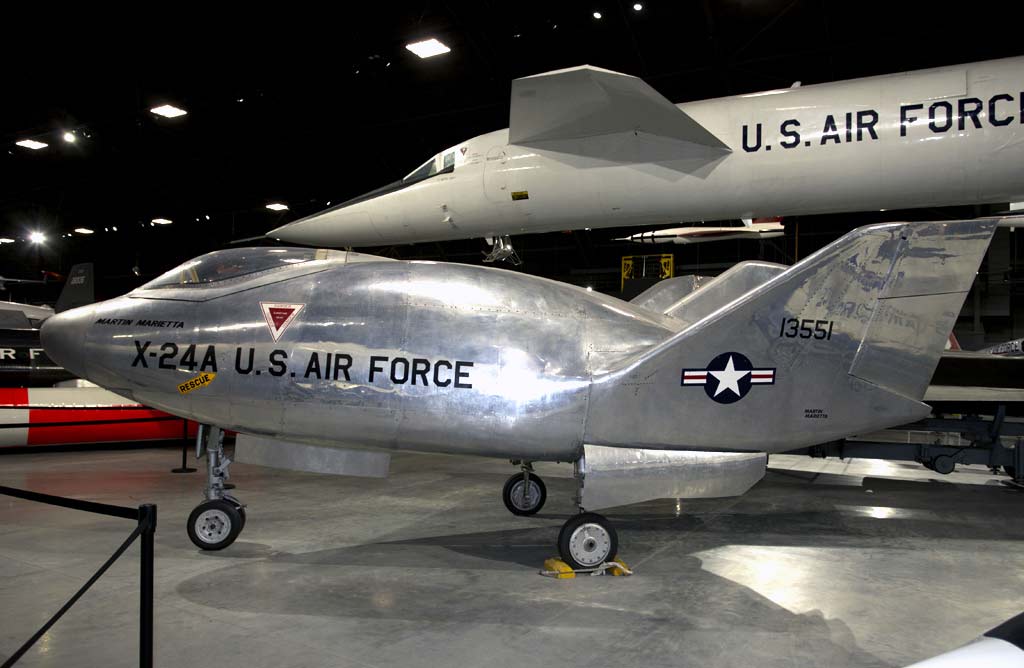The Martin X-24A was an experimental aircraft designed to explore the principles of lifting body configurations, crucial for spaceflight re-entry.
In brief
The Martin X-24A, developed in the 1960s, was an innovative lifting body aircraft, part of a joint research program by NASA and the U.S. Air Force. This program aimed to investigate the feasibility of unpowered re-entry and landing techniques for future spacecraft. The aircraft had a distinctive, flatiron shape with no conventional wings, utilizing its body to generate lift. Powered by a single rocket engine, the X-24A conducted glide and powered flights to study aerodynamic characteristics, control mechanisms, and landing capabilities essential for the safe return of spacecraft from orbit. It significantly contributed to understanding and developing technology for space shuttle operations and other re-entry vehicles.
History of the Development of the Martin X-24A
The Martin X-24A emerged during an era when space exploration was rapidly evolving. Post-World War II, with the advent of rocket technology and early space missions, there was a growing need to understand how vehicles could re-enter Earth’s atmosphere and land safely. The concept of a lifting body, which could generate lift and control without traditional wings, was of particular interest for its potential to enhance the safety and versatility of future spacecraft.
Developed in collaboration with NASA, the U.S. Air Force, and Martin Marietta, the X-24A was part of the broader lifting body research program that included several other experimental vehicles. The program’s objective was to validate the concept of atmospheric re-entry with a vehicle that could later transition to a horizontal landing, offering a reusable spacecraft solution. The X-24A first took to the skies on April 17, 1969, piloted by Jerauld R. Gentry, marking a significant milestone in aerodynamic and space re-entry research.
Design of the Martin X-24A
The X-24A’s design was groundbreaking, featuring a blunt, wedge-shaped body that could generate adequate lift for controlled flight, a departure from conventional aircraft designs. This flatiron or lifting body design minimized the need for wings, reducing weight and increasing the vehicle’s re-entry survivability. It was equipped with a Reaction Motors XLR-11 rocket engine, initially used on the Bell X-1, providing the necessary thrust for high-altitude research flights.
The aircraft incorporated sophisticated flight control systems to manage its unconventional flight characteristics, especially during the approach and landing phases, where traditional aerodynamic controls were ineffective. The X-24A’s design allowed for detailed examination of lift-to-drag ratios, thermal protection requirements, and the aerodynamic stability of lifting body vehicles, contributing valuable data for the development of future spacecraft, including the Space Shuttle.

Performance of the Martin X-24A
The X-24A demonstrated significant capabilities in its test flights, reaching speeds of up to Mach 1.6 and altitudes exceeding 70,000 feet. The aircraft’s performance provided essential data on low-speed handling, high-speed aerodynamics, and the transition between subsonic, transonic, and supersonic flight regimes. Its ability to glide to a runway landing after re-entry was pivotal, offering insights into controllable, piloted landings for future space missions.
The experimental flights of the X-24A helped to refine the understanding of lifting body aerodynamics, influence the design of thermal protection systems, and improve flight control strategies for atmospheric re-entry from space.
Variants of the Martin X-24A
The X-24A underwent a significant transformation during its service:
- X-24A: The original configuration with its distinctive flatiron shape, used for initial testing.
- X-24B: A modification of the X-24A airframe to test a different lifting body shape, featuring a more conventional-looking fuselage and improved aerodynamic performance. This redesign significantly influenced the development of later spaceplane concepts.
Military Use and Combat of the Martin X-24A
The Martin X-24A was strictly an experimental aircraft and was not designed for combat or any military application outside of its research role. Its primary mission was to contribute to aerospace research, particularly in the fields of aerodynamics and spaceflight re-entry. The data and insights gained from the X-24A’s flights were instrumental in advancing military aerospace technology, indirectly supporting the development of technologies that could be applied to military aircraft and spacecraft.
–
The Martin X-24A was a cornerstone in the history of aerospace research, playing a crucial role in advancing the understanding of lifting body principles and significantly impacting the design and development of future re-entry vehicles, including the Space Shuttle. Its contributions to aerodynamics, control in multiple flight regimes, and safe re-entry and landing techniques have had lasting impacts on both military and civilian aerospace endeavors.
Back to the experimental aircraft section.